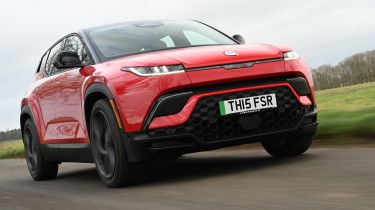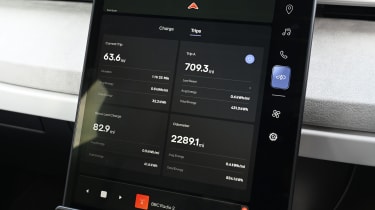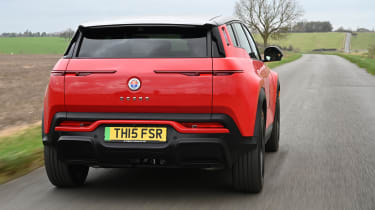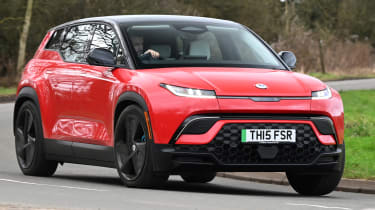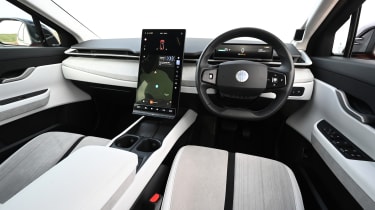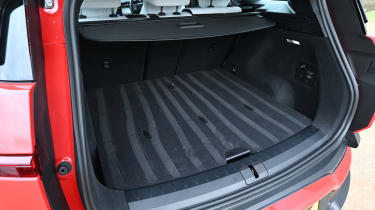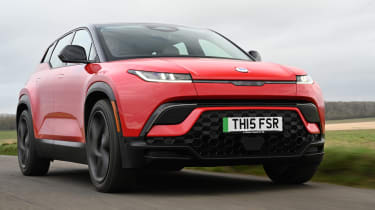Fisker Ocean review: electric family SUV tries to run before it can walk
The Fisker Ocean SUV looks to be a class-leader on paper, however, a firm ride, a cheap-feeling interior and the lack of certain features hold it back from greatness
Pros
- Sustainable design
- Exceptionally fast
- Affordable base model
Cons
- Firm ride
- No Apple CarPlay and Android Auto
- Lacklustre interior quality
Fisker Ocean verdict
In many ways, the Fisker Ocean feels like a promising crowdfunding project that’s still in its Beta phase; the car we drove was still awaiting several software updates to fix some glaring issues and add in some crucial features. However, some fancy coding cannot fix the Fisker’s relatively cheap-feeling interior, which is a result of the car being built to a tight budget. This is a shame as the Ocean is otherwise an impressive feat with a class-leading range figure, exhilarating performance, a highly competitive starting price and a multitude of fun – and sometimes even useful – features that you cannot find anywhere else. If Fisker can manage to overcome these teething issues, the Ocean could well progress to become the leader of its family SUV segment – just not quite yet.
Details, specs and alternatives
You’d be forgiven for having never heard of Fisker – and actually, we doubt the maker would mind all that much. Founded in 2007, until recently its only model was the Fisker Karma – a high-end plug-in hybrid saloon car that ended up selling only 2,000 units before production was suspended in late 2012.
Now, the company is back – still owned and run by founder Henrik Fisker – but with punchy plans to revolutionise the electric car market. Its first car is the Fisker Ocean, a premium SUV with a focus on technology and sustainability. Prices start from £35,970, and the more affordable Fisker Pear is due soon.
The Fisker Ocean is a rival to the Tesla Model Y, BMW iX3 and Mercedes EQC. It’ll be built in Austria by third party Magna – a company also responsible for the assembly of other big-brand cars, including those from Fisker’s aforementioned German rivals.
Fisker is offering the Ocean in three specifications, which use two different battery setups; the entry-level Fisker Ocean Sport adopts that competitive £35,970 price tag and gets a 71kWh battery pack which provides a range of up to 288 miles. The mid-spec ‘Ultra’ and flagship ‘Extreme’ models both utilise a much larger 106kWh unit which, according to fisker, provides a range of up to 440 miles, making the Ocean one of the longest-range electric cars you can buy.
Base Sport versions of the Fisker Ocean get a single 271bhp motor to power the front axle, which should provide sufficient performance for most buyers. Stepping up through the range brings the option of dual-motor all-wheel drive, with the highest-spec Extreme car boasting 557bhp and a 0-62mph time of just 3.9 seconds.
Despite its competitive starting price, even the entry-level Fisker Ocean Sport gets a panoramic roof, a 17.1-inch central screen, heated front seats, a powered bootlid, a digital rear-view mirror and loads of safety features.
Ultra trim ramps up the kit count with an opening panoramic roof, an upgraded stereo, Alcantara upholstery and the much-discussed ‘California Mode’ – more on that later. It also adds a second motor for all-wheel drive, plus the bigger battery option for up to 379 miles of range. Extreme cars get a rotating centre screen, 3D cameras, solar panels on the roof and heated rear seats among other things.
Range, battery size & charging
|
Model |
Range |
Wallbox charge time |
Rapid charge time |
|
Sport |
288 miles |
9.5hrs est (0-100%, 7.4kW) |
TBC |
|
Ultra |
429 miles |
14.5hrs est (0-100%, 7.4kW) |
33 mins (10-80%, 180kW) |
|
Extreme |
440 miles |
14.5hrs est (0-100%, 7.4kW) |
33 mins (10-80%, 180kW) |
Top-spec versions of the Fisker Ocean Extreme get a huge 113kWh (106kWh usable) battery for an official range of 440 miles – although this drops slightly to 436 miles if you go for the larger 22-inch wheels. Those numbers make it one of the longest-range electric cars on sale, beating the most efficient Tesla Model Y Long Range and the Renault Scenic.
That said, we struggled to get anywhere near this figure during our tests; we returned an efficiency of 2.5 miles per kilowatt-hour, which only translates to a real-world range of around 265 miles – over 20 miles less than what is supposedly possible in the base Ocean Sport.
Fisker hasn’t confirmed peak charging speeds, though industry body CAP quotes a 180kW maximum for the Ocean Extreme – meaning the SUV is good for a 10-80% charge in a little over 33 minutes on models with the bigger battery. That compares favourably with those aforementioned rivals, especially when you consider how much larger the Fisker’s battery is.
Top-spec Ocean Extreme cars also get a solar roof, which Fisker claims can add up to 1,500 miles of range every year. Take this with a pinch of salt, as while handy, it’s unlikely to have the same effect in Croydon as it might in California.
Running costs & insurance
For an electric SUV, the Fisker Ocean isn’t all that expensive in its base form – even when you consider similarly-sized petrol rivals. Being an electric car, it’s also subject to the same rock-bottom 2% Benefit-in-Kind tax banding as all other zero-emissions models. This means that even in the priciest Ocean Extreme spec, higher-rate taxpayers would be liable for just £487 per year – opt for the smaller-battery Ocean Sport and you can expect to pay even half that figure.
One thing we will say, however, is that it’s far from the most efficient model you can buy; we’ve already mentioned the disappointing miles per kWh figure we achieve in real-world driving, but it’s also worth considering how much it’ll cost to charge the Ocean’s huge battery. Entry-level Sport cars shouldn’t be too pricey to run, though it’ll set you back over £30 to charge the 106kWh Ultra and Extreme models at home at the current average electricity rate. Pricey public rapid chargers mean a 10-80% charge could set you back as much as £60.
That’s not all, as every version of the Fisker Ocean will cost an arm and a leg to insure, too. Base Sport models occupy group 42, while Ultra and Extreme models find themselves in the top group 50. With this in mind, the Fisker should cost roughly the same to insure as a Tesla Model Y – not exactly a good thing when you consider rivals like the Volkswagen ID.4 can be covered for significantly less.
Performance, motor & drive
|
Model |
0-62mph |
Top speed |
Driven wheels |
Power |
|
Sport |
7.4s |
99mph |
Front |
271bhp |
|
Ultra |
4.2s |
124mph |
Four |
529bhp |
|
Extreme |
3.9s |
128mph |
Four |
557bhp |
Like many EVs, you don’t need to switch the Fisker Ocean on; provided the key is in the car, you just sit down, put your foot on the brake pedal and the car comes to life. It launches in ‘Earth’ mode – a kind of eco setting that limits power for maximum range, though we found this setup perfectly pleasant for daily duties.
‘Fun’ ramps things up, while ‘Hyper’ (only on Ultra and Extreme) brings a Boost mode for full performance (up to 557bhp) – freeing up the possibility of 0-62mph in just 3.9 seconds. It’s a fast car, for sure, but it pays to take a more relaxed approach at times; the Fisker Ocean is heavy. Body control is surprisingly tight, but the seats lack support – so you feel as if you’re being thrown about a bit during quick cornering.
The steering could do with a bit more feel – like a number of the Ocean’s rivals – and despite the brakes now being less spongy than pre-production models we’ve tried, the Ocean still offers zero form of one-pedal driving; there is a noticeable amount of regenerative braking to slow the car down, but it won’t bring the car to a complete stop. Hopefully this might be added in a future update.
What a software update will struggle to fix, however, is the ride; despite being honed on pothole-laden UK tarmac (the brand has a base in Banbury, Oxfordshire) the Ocean feels noticeably firm. Again, this is not something unique to the Fisker – plenty of EVs have stiffer suspension to compensate for their hefty weight – but we’d like a little more cushion over rougher roads. Our car came fitted with the largest 22-inch wheels and we’d recommend sticking with the smaller 20-inch alloys that come as standard as this should hopefully take the edge off things somewhat.
Interior, dashboard & infotainment
First things first, it’s important to note that the Fisker Ocean starts from around £36,000, with top models costing almost twice that amount. With this in mind, you’ll find that while interior quality is certainly par-for-the-course on base models, many of the cheap-feeling plastics – such as those used on the door handles – don’t feel befitting of top models that are priced in-line with premium rivals from BMW and Mercedes.
That aside, the interior centres around a frankly huge 17.1-inch central touchscreen, which can rotate in high-spec cars into a so-called ‘Hollywood Mode’ – giving users a landscape view for watching films or streaming services while charging. An update coming later this year will introduce Apple CarPlay or Android Auto connectivity, which is a good thing as while the screen itself is certainly crisp and responsive, the built-in TomTom sat nav feels a tad aftermarket and doesn’t even come close in terms of appearance and functionality to the slick Google-based system in the Renault Scenic.
Hidden vents sit within the dashboard, controlled via that big display. Not all the buttons are nestled within, however, as a row of physical controls beneath the screen allow access to things like temperature and media volume, as well as offering a shortcut for the windscreen demister.
The Ocean is designed to be as sustainable as possible from the point of manufacture. As such, there is no leather inside – not even as an option. Entry-level cars get black fabric seats, while top-of-the-range examples get contemporary suede upholstery with a choice of different colours.
Boot space, seating & practicality
|
Length |
Width |
Height |
Boot space (seats up/down) |
|
4,774mm |
2,147mm |
1,629mm |
476/918 litres |
For such a large car, the Fisker’s on-paper boot space figures aren’t that impressive. Indeed, 918 litres (seats down) is smaller than the space you’ll find in a Peugeot E-208 supermini. In reality, however, the Ocean is much more spacious than these numbers suggest; we suspect the conversion from cubic feet to litres – remember Fisker is an American brand – may not translate.
All cars get a big square boot opening with a low and flat loading lip. There’s storage under the floor for the charging cables and a good few hooks for hanging your shopping. The rear window lowers electronically – like a first-generation Land Rover Freelander – to help when carrying longer items, while some versions get a ‘California Mode’ which can lower all the windows (including the sunroof) at once to give a true open-air feeling. Overall, the Ocean appears well thought-out.
Inside, there’s plenty of space for passengers, too. You’ll seat four easily, while three across the back is easier than you might think thanks to the flat floor and raised centre console, which allows space to slide your feet forward. We also cannot forget to mention what Fisker calls a ‘Taco Tray’ (or what we cynically refer to as the ‘Fish and Chip Flap’) which folds up from the centre console to give the driver somewhere to eat or work.
Reliability & safety rating
It’s not often we review a car completely devoid of reliability data. Normally, even if it’s a new model, the manufacturer has historic stats for its other cars – allowing us to at least gauge how dependable the new version might turn out to be. With Fisker, however, it’s largely unknown.
That said, the maker is using industry stalwart Magna to build its cars in Austria – the same company who assembles various Mercedes and BMW models. This puts Fisker in a good position from the off, at least with regards to build quality. The fact that electric cars have fewer moving parts than petrol or diesel models should reduce the risk of early niggles, too.
We expect the Fisker Ocean to be a safe car, too, though independent crash test body Euro NCAP hasn’t yet subjected the SUV to its stringent assessments. There are various driver assistance systems that can be switched on or off via the main touchscreen, while the semi-autonomous Fisker Intelligent Pilot system can take the strain on longer motorway journeys.
